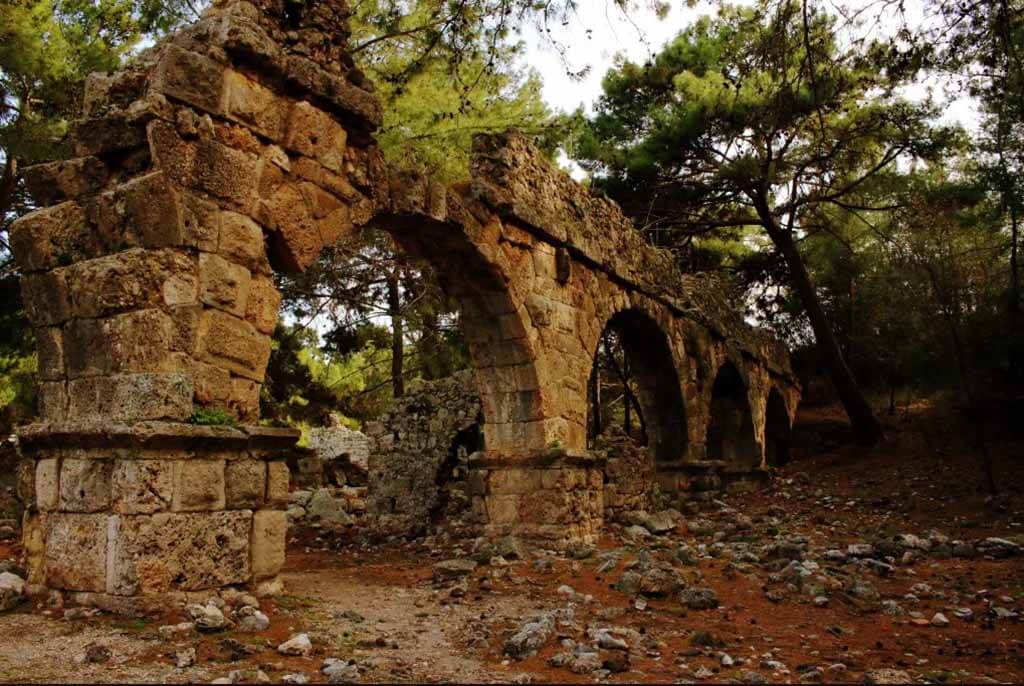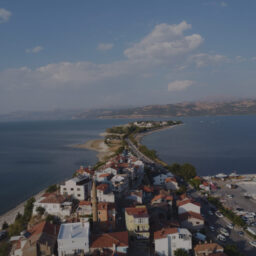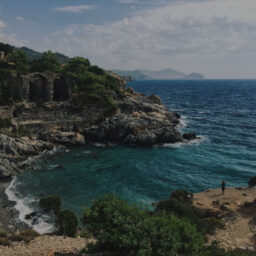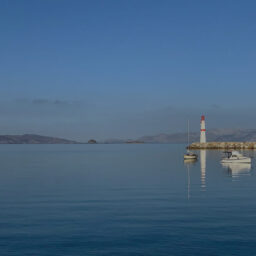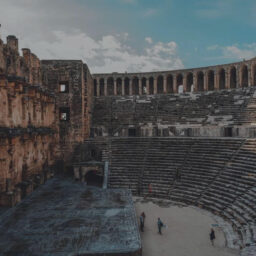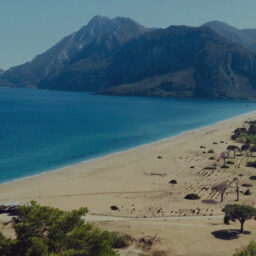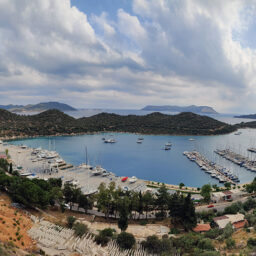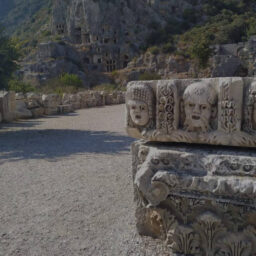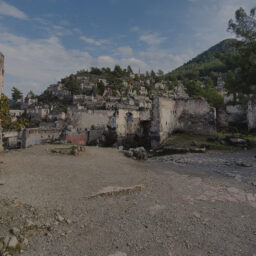Phaselis Ancient City: A Journey Through Time
Table of Contents
ToggleAh, Phaselis! A name that evokes images of ancient ruins, sun-kissed beaches, and a rich tapestry of history.
Nestled in the heart of Lycia, this Roman City near Tekirova, Antalya has been a magnet for history buffs and beach lovers alike. But what makes Phaselis so special? Let’s dive in!
The Rich Tapestry of Phaselis: A Historical Overview
The ancient city of Phaselis, with its sun-kissed shores and majestic mountains, has a history that is as captivating as its landscapes.
Let’s embark on a journey through time and unravel the intricate tapestry of Phaselis.
Founding and Early Years
Phaselis, believed to have been established by colonists from Rhodes in the 7th century B.C., was strategically positioned with the Taurus Mountain range as its backdrop.
This geographical advantage facilitated the easy transfer of timber from the mountains to the city and its ships.
As a result, Phaselis quickly rose to prominence as a pivotal trading hub, fostering commerce between nations such as Egypt, Syria, Greece, and other Mediterranean territories.
The city boasted three ports, all natural harbors, located on the north, northeast, and southwest coasts of the peninsula.
A City Under Many Flags
The political landscape of Phaselis was as dynamic as its trade routes. The city witnessed a series of rulers:
- Persian Rule (5th century B.C.): The Persians were among the first to recognize the city’s potential, bringing it under their dominion.
- Carian Rule (4th century B.C.): The Carians, another influential group, later took control of Phaselis.
- Alexander the Great (333 B.C.): The legendary conqueror marched into Phaselis, marking a significant chapter in its history.
- Lycian Federation (2nd century B.C.): Under the Lycians, Phaselis enjoyed a period of relative stability and growth.
- Roman Empire (43 B.C. onwards): The Romans ushered in a 300-year era of reconstruction for Phaselis. The city’s significance was further amplified after a visit from the Roman Emperor Hadrian. This led to Phaselis becoming an integral part of the Byzantine Empire in the subsequent 5th and 6th centuries, even gaining recognition at the council of Chalcedon in 451.
Decline and Resurgence
However, like all great cities, Phaselis faced its share of challenges. The 7th century saw the city’s decline, primarily due to persistent pirate attacks and external invasions.
But the indomitable spirit of Phaselis shone through as it regained its opulence in the 8th century under Byzantine rule.
Remnants of this era, including city walls and various ruins, stand testament to its resilience.
The Sunset of Phaselis
Despite its resurgence, Phaselis couldn’t maintain its trading supremacy.
The weakening of the Byzantine Empire and the rise of harbors in Antalya and Alanya shifted trade dynamics.
By the time the Seljuks conquered Phaselis in 1158, its significance as a trade center had waned.
The city’s decline continued until it was completely abandoned in the 13th century.
Throughout its history, Phaselis revered Athena, the Goddess of war and wisdom, as its primary deity.
Her influence, perhaps, guided the city through its many battles, both literal and metaphorical.
How to Get to Phaselis from Antalya or Kemer
The ancient city of Phaselis, with its rich history and breathtaking landscapes, is a must-visit for any traveler in Turkey.
Nestled within the administrative confines of Tekirova in the Kemer District, Phaselis is conveniently accessible from various key locations.
Here’s a detailed guide on how to reach this historical gem:
- From Antalya: 59 km
- From Olympos: 29 km
- From Kemer: 15 km
Reaching Phaselis from Antalya and Kemer
By Minibus (Dolmuş)
- Direct Route from Antalya: If you’re near the 5M Migros in Antalya, you’re in luck! Direct minibuses to Tekirova are available here, making your journey straightforward.
- Alternate Route from Antalya: Not near 5M Migros? No worries. You can hop on any minibus heading to Kemer. Once in Kemer, look for the minibus departure point opposite the Clock Tower. This minibus will take you straight to Phaselis.
- From Kemer: If you’re starting your journey from Kemer, simply head to the minibus departure point opposite the Clock Tower. Busses to Phaselis depart every half-hour, ensuring you won’t have to wait long.
The minibus ride typically takes about 30 minutes. Once you alight at the Phaselis turnout, a picturesque 1 km walk awaits you, leading to the port.
By Private or Rental Car
If you’re someone who loves the freedom of driving, Phaselis has got you covered.
A spacious parking lot is available for those traveling with private or rental cars.
This option gives you the flexibility to explore the area at your own pace.
Reaching Phaselis from Antalya Airport
Starting your journey from Antalya Airport?
Here’s a step-by-step guide:
- From the Airport to Kemer: Multiple transportation options are available. You can choose between the tram, municipal bus, or the HAVAŞ shuttles, all of which will take you to Kemer.
- From Kemer to Phaselis: Once you reach Kemer square, look for the minibus heading to Phaselis. This will be your final leg of the journey to the ancient city.
And if you’re planning a longer stay in the region, don’t miss out on the other attractions in the area. Check out this guide on top things to do in Kemer for some inspiration.
Main Attractions in Phaselis
Hadrian’s Arch
Hadrian’s Arch, located at the south entrance of Phaselis’ harbor street, stands as a testament to the city’s rich Roman ties.
Erected in AD 131, this grand edifice was built to honor the Roman Emperor Hadrian’s visit.
Its enduring support legs, still prominent on the main street, showcase Roman architectural brilliance.
A special dedication to Emperor Hadrian is etched on the architrave blocks, offering a glimpse into the era’s cultural reverence.
Just a stone’s throw away lies the agora, an ancient hub of trade and social interaction, emphasizing the area’s historical significance.
This arch, beyond its architectural beauty, bridges the present to a time of emperors and grand celebrations.
Roman Baths
A testament to the Roman’s love for luxury, the Roman Baths in Phaselis are a must-visit.
Imagine the elite of the Byzantine Period relaxing in these baths, discussing politics and philosophy.
Theaters and Agoras
Nestled in Phaselis are the remnants of a small theater, emblematic of the Hellenistic Period’s architectural prowess.
This structure, with traces of a stage addition from the Roman era, showcases a blend of ancient architectural styles.
While its origins trace back to the 2nd century, there’s evidence suggesting an even older theatrical presence at this site.
This theater wasn’t merely an entertainment venue; it was a cultural epicenter, reflecting Phaselis’ rich artistic heritage.
With a capacity to accommodate around 1,500 spectators, it served as a communal hub where citizens congregated for performances and social interactions.
Today, this theater stands as a testament to Phaselis’ vibrant cultural past, echoing the timeless allure of art and community gatherings.
Aqueducts and Protection Walls
Phaselis, a city with a rich history, was strategically fortified with walls extending from the sea.
These walls served a dual purpose: they not only defined the city’s boundaries but also shielded its inhabitants from frequent pirate incursions.
Their presence underscores the city’s vulnerability to maritime threats and its resilience in safeguarding its people.
Parallel to the city’s defensive measures are the aqueducts, stretching approximately 450 meters. Remarkably, these aqueducts stand as the oldest surviving structures in Phaselis.
Beyond their architectural significance, they highlight the city’s advanced engineering capabilities and its emphasis on ensuring a steady water supply for its residents.
Together, the protection walls and aqueducts paint a picture of a city that was both fortified against external threats and equipped to sustain its populace.
The Beaches of Phaselis
Phaselis, renowned for its historical significance, also boasts a trio of captivating beaches nestled within its three harbors: North, Central, and South.
- North Harbor Beach: Located near the entrance, this is the second-largest beach in Phaselis. Its calm coastline, coupled with crystal-clear, pebbled waters, offers a serene escape for those seeking tranquility.
- Central Harbor Beach: A hidden gem, this beach is the smallest yet arguably the most idyllic. Encircled by rounded stones and lush trees, it feels like a secluded natural pool. A unique feature is its water temperature, which is slightly warmer than the nearby Kemer, adding to its allure.
- South Harbor Beach: The most expansive and frequented of the three, the South Harbor Beach is a hub of activity. Its popularity is not just due to its size but also the amenities it offers. Beachgoers can find facilities like restrooms and showers, ensuring a comfortable day out by the sea.
Whichever beach you choose in Phaselis, be sure to consider the day’s wind and wave conditions to optimize your experience.
Each beach, with its distinct charm, promises a memorable seaside retreat.
Entrance, Opening Hours, and Tickets
Planning a visit to the historic Phaselis? Here’s everything you need to know about its timings and ticketing:
Opening Hours
- Spring & Summer (April-October): Phaselis opens its gates every day from 08:30 in the morning until 19:30 in the evening, allowing visitors ample time to explore its rich heritage during the longer daylight hours.
- Autumn & Winter (November-March): The ancient city welcomes visitors daily from 08:30 in the morning to 17:30 in the evening, adjusting for the shorter days.
Ticket Information
- Entrance Fee: The standard admission price for Phaselis is 220 lira per person. If you’re driving in, you’ll be pleased to know that parking your car is free of charge.
- Museum Card Benefits: If you possess a museum card, you’re in for a treat! Cardholders are eligible for a generous 40% discount on the standard ticket price, making the exploration of Phaselis even more enticing.
Whether you’re a history buff, an avid traveler, or someone looking for a unique experience, Phaselis promises a journey back in time.
Just ensure you align your visit with the operational hours and take advantage of any discounts available!
Conclusion
Phaselis is not just an archaeological site; it’s a journey through time. From its Roman Baths to the tales of Alexander the Great, every corner has a story to tell.
So, the next time you’re in Tekirova, Antalya, make sure to take a detour to this historical gem.
And while you’re at it, why not explore more of what the region has to offer? Here’s a comprehensive guide to the Turkish Riviera to get you started. Happy travels and may the ancient spirits of Phaselis guide your way!
Where is Phaselis located and what is its historical significance?
Phaselis is an ancient city in the heart of Lycia, near Tekirova, Antalya. Established in the 7th century B.C., it became a pivotal trading hub, witnessing a series of rulers from Persians to Romans.
How was Phaselis founded and what was its role in ancient trade?
Phaselis was believed to be founded by colonists from Rhodes. Due to its strategic location near the Taurus Mountain range, it facilitated timber transfers and became a significant trading center with Egypt, Syria, Greece, and other Mediterranean territories.
What are the main attractions in Phaselis?
Some main attractions include Hadrian's Arch, the Roman Baths, ancient theaters and agoras, aqueducts and protection walls, and its three beautiful beaches: North, Central, and South Harbor Beaches.
How can one reach Phaselis from Antalya or Kemer?
Phaselis is 59 km from Antalya and 15 km from Kemer. It's accessible by minibus from both cities or by private or rental cars. If you're coming from Antalya Airport, multiple transportation options will take you to Kemer, from where you can catch a minibus to Phaselis.
When can I visit Phaselis and what is the entrance fee?
Phaselis is open from 08:30-19:30 during spring & summer (April-October) and 08:30-17:30 during autumn & winter (November-March).
The standard admission is 220 lira per person, with a 40% discount for museum cardholders. Parking is free for those driving in.








